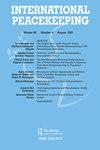Protecting Civilians: Mission Critical or Mission Impossible?
IF 1.3
2区 社会学
Q2 INTERNATIONAL RELATIONS
引用次数: 0
Abstract
UN iconography around the protection of civilians in conflict contexts tends to be disarmingly reassuring. In one striking – if not atypical – image, a lightskinned and lightly-armed peacekeeper stands silent watch as an African woman goes about her daily business of gathering wood. Beyond the gendered and neocolonial tropes that are hard at work in this particular photo – evoking ‘white men saving brown women from brown men’ – the message conveyed is one of quiet professionalism, with the UN’s thin blue line unthreateningly keeping out-of-frame dangers at bay, enabling everyday life to carry on. While the protection of civilians (PoC) in conflict-affected contexts has become increasingly central to contemporary peace operations, in reality the exercise of armed international agency in defence of the vulnerable has a decidedly uneven track record, and peacekeeping itself has proven to be an awkward and imperfect instrument of protection. Too often, despite strong mandates authorizing ‘all means necessary’, peacekeepers have failed to act, with disastrous consequences. Sexual abuse and exploitation scandals, in which peacekeepers prey on the very populations they are sent to protect, have also continued to plague UN operations and undermine their credibility with host populations. And even in cases where the UN can justifiably claim to have been instrumental in saving thousands of lives – as with South Sudan’s PoC sites – in circumstances保护平民:关键任务还是不可能任务?
联合国关于在冲突环境中保护平民的形象往往令人放心。在一张引人注目(如果不是非典型的话)的照片中,一名身穿浅色衣服、全副武装的维和人员静静地站在那里,看着一名非洲妇女从事她的日常拾木工作。除了这张照片中难以奏效的性别和新殖民主义比喻——唤起“白人男性从棕色男性手中拯救棕色女性”——传达的信息是一种安静的专业精神,联合国的细蓝线毫无威胁地阻止了画面外的危险,使日常生活得以继续。尽管在受冲突影响的环境中保护平民已成为当代和平行动的核心,但事实上,武装国际机构在保护弱势群体方面的表现显然参差不齐,维和本身已被证明是一种尴尬和不完善的保护手段。尽管有强有力的授权“采取一切必要手段”,但维和人员往往未能采取行动,造成灾难性后果。维和人员掠夺被派去保护的人群的性虐待和性剥削丑闻也继续困扰着联合国的行动,并破坏了他们在东道国民众中的信誉。即使在联合国可以理直气壮地宣称在拯救数千人生命方面发挥了作用的情况下——就像南苏丹的PoC遗址一样——在这种情况下
本文章由计算机程序翻译,如有差异,请以英文原文为准。
求助全文
约1分钟内获得全文
求助全文

 求助内容:
求助内容: 应助结果提醒方式:
应助结果提醒方式:


